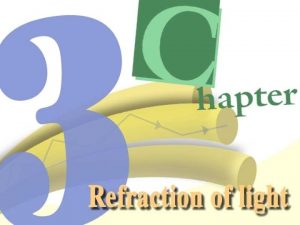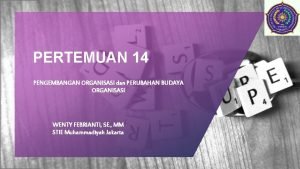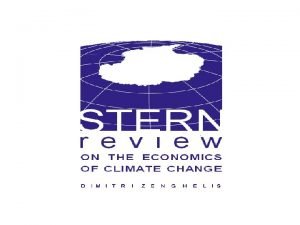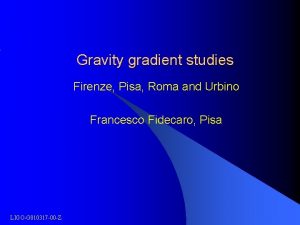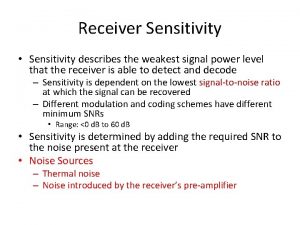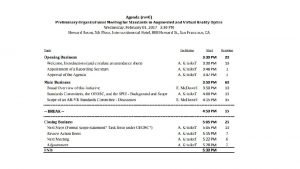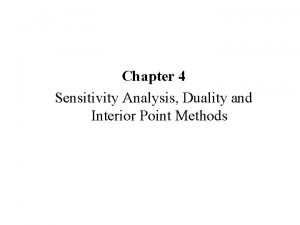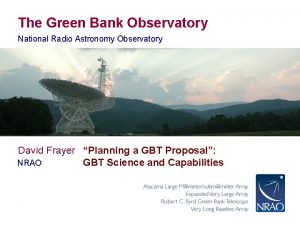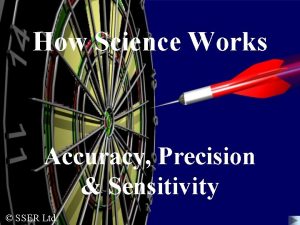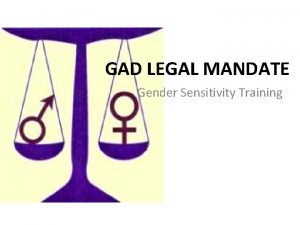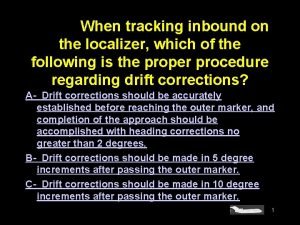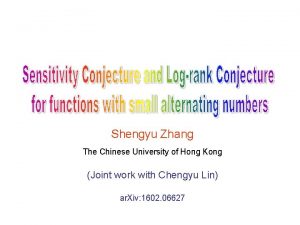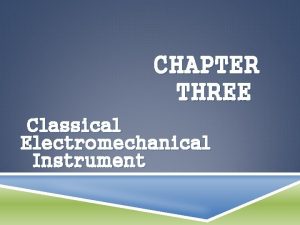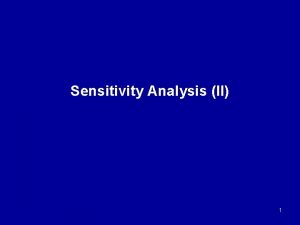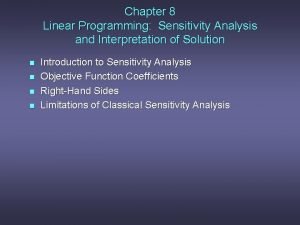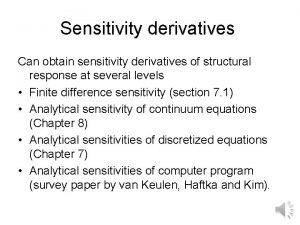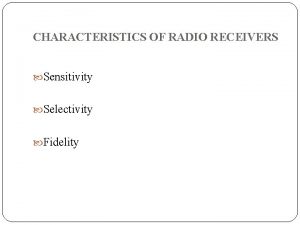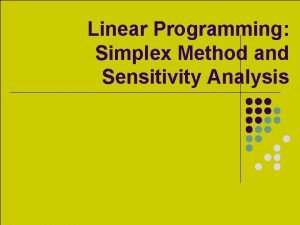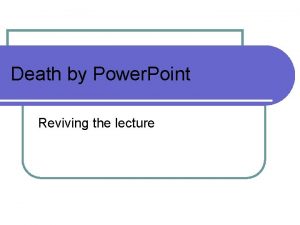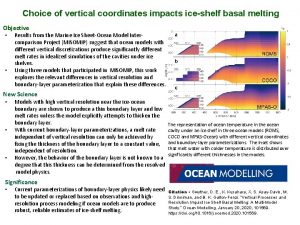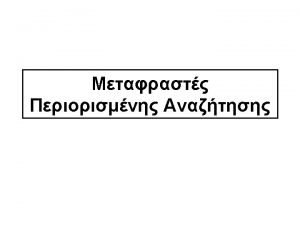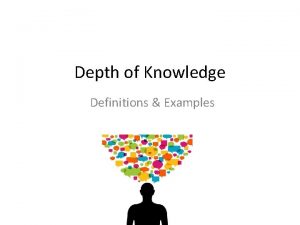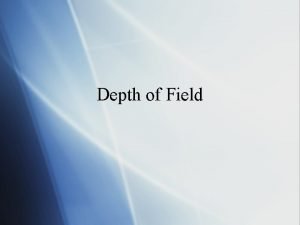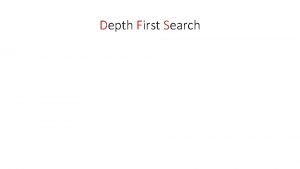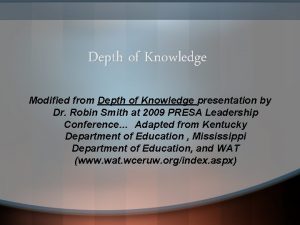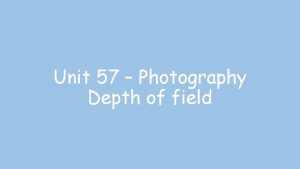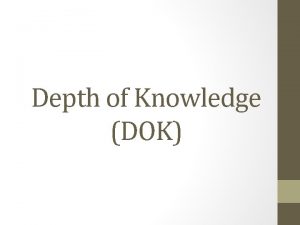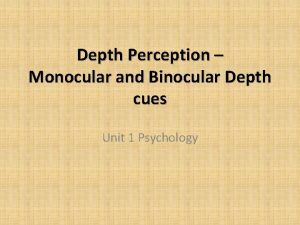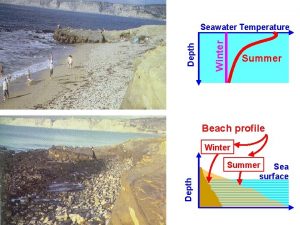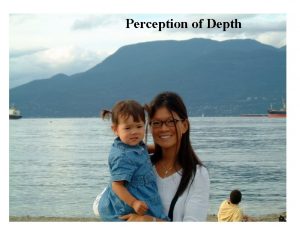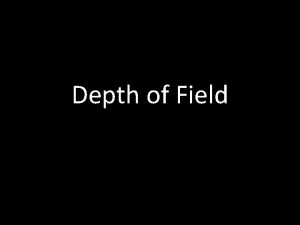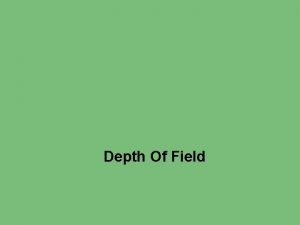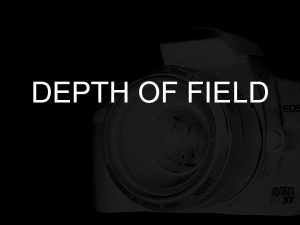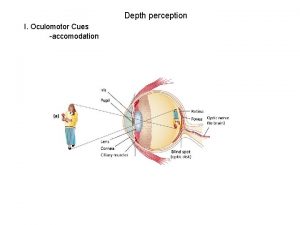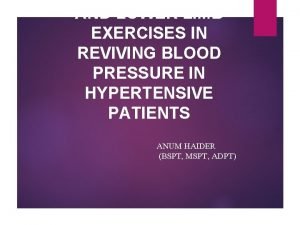Reviving Depth sensitivity in MITgcm Sensitivity of iceshelf

























- Slides: 25

”Reviving” Depth sensitivity in MITgcm: Sensitivity of ice-shelf melt to bathymetric uncertainty Daniel N Goldberg 1, Tim Smith 2, Krishna Narayanan 3, Patrick Heimbach 1, 2, 4 1 University of Edinburgh, School of Geo. Sciences 2 Institute for Computational Engineering and Science, UT-Austin 3 Math and Computational Science, Argonne National Lab 4 Jackson School of Geosciences, UT-Austin Mathematical Modelling in Glaciology, Banff Int’l Research Station, 14 Jan 2020

Adjoint Ocean Models • Adjoint models of ocean circulation represent powerful tools for analysing oceanic drivers (cf Patrick’s Talk) • They can be used to assess high-dimensional (infinite-dimensional) gradients of model outcomes with respect to parameter/input fields • e. g. , Surface Wind Forcing (Jones et al, 2018) • or Bottom Topography (Losch and Heimbach, 2007) • … which can then be used to characterise the impact of uncertainty in these fields

Impact of Bathymetry on ice-shelf cavities Morlighem et al, 2019 Impact of bathymetric uncertainty on under-ice circulation is quite important to constrain: • Bathymetry has strong impact on cavity circulation; • And our understanding of ice-shelf bathymetry is being constantly rewritten! Dutrieux et al, 2014 Millan et al, 2017 Wei et al, 2019

Sensitivities versus Uncertainty • CAVEAT – This work is NOT uncertainty quantification • This would involve a multivariate posterior probability distribution of a VERY high dimensional set of parameters • HOWEVER – adjoint sensitivities have been a prerequisite to UQ in a number of ice- and ocean studies (e. g. Isaac et al, 2015; Kalmikov and Heimbach, 2014) • Adjoint sensitivities of ice-shelf melt to bathymetry has not been previously studied – and such is the focus of this work

Previous work and Difficulties • MITgcm adjoint has been used to study melt rates before (e. g. Heimbach and Losch, 2012), though sensitivity to bathymetry not considered • In part due to code structure (to facilitate Algorithmic Differentiation, code must be designed with AD in mind) • Implementation of bathymetry in MITgcm is nondifferentiable, with “kinks” and discontinuities… Heimbach and Losch, 2012 from mitgcm. org fluid hw. Dz bed hc. Dz Dz

Previous work and Difficulties • MITgcm adjoint has been used to study melt rates before (e. g. Heimbach and Losch, 2012), though sensitivity to bathymetry not considered Heimbach and Losch, 2012 • In part due to code structure (to facilitate Algorithmic Differentiation, code must be designed with AD in mind) • Implementation of bathymetry in MITgcm is nondifferentiable, with “kinks” and discontinuities… from mitgcm. org fluid hw. Dz dzb bed hc. Dz Dz

Previous work and Difficulties • MITgcm adjoint has been used to study melt rates before (e. g. Heimbach and Losch, 2012), though sensitivity to bathymetry not considered Heimbach and Losch, 2012 • In part due to code structure (to facilitate Algorithmic Differentiation, code must be designed with AD in mind) • Implementation of bathymetry in MITgcm is nondifferentiable, with “kinks” and discontinuities… from mitgcm. org fluid hw. Dz dzb bed hc. Dz Dz

Previous work and Difficulties • MITgcm adjoint has been used to study melt rates before (e. g. Heimbach and Losch, 2012), though sensitivity to bathymetry not considered Heimbach and Losch, 2012 • ”Smoothing” of kinks (Losch and Heimbach, 2007) can partly address these issues but still gradients tend to be noisier than other fields Sensitivity of MOC to bathy Sensitivity of MOC to winds

New development • Timestepping the barotropic mode in MITgcm involves solution of an elliptic PDE Ax = b • But A depends on ocean depth, so adjoint equations become (Giles, 2002) (1) AT (d*b) = d*x (2) d*A = - d*b x. T (1) already implemented in MITgcm code, (2) is new • Finally – we are working with open-source tool Open. AD (as opposed to TAF)! • Additional changes to “restart” adjoint (Open. AD-DIVA) …

2 Experiments 1. Idealised experiment (ISOMIP with ridge) in order to make sense of bathymetric influence 2. Application to realistic domain (Dotson + Crosson ice shelves) to place (1) in context

ISOMIP-Ridge ISOMIP configuration (Holland, 2003) • Idealised cavity filled with cold water, circulation driven by “ice-shelf pump” • Modified with undersea ridge, spun up for 1 decade North Overturning streamfunction (contours) and temperature (shading) Barotropic streamfunction (contours) and melt rate (shading)

ISOMIP-Ridge Sensitivity Experiment Open ocean 1 2 3 ridge 4 Grounding line Red: Raised bed More melt Blue: Raised bed Less melt

ISOMIP-Ridge Perturbation Experiments 1 2 • Seaward of ridge: perturbations induce broad circulation • Similar to interaction with seamount (e. g. Holland, 2001; Huppert and Bryan, 1976) Thick contours: Bathymetric perturbation (positive) Shading: Perturbed Barotropic Streamfunction (red = counterclockwise) • Likely affects melt by acting with or against mean circulation

ISOMIP-Ridge Perturbation Experiments 3 4 • On Ridge: more complicated but broadly the same effect • Likely affects position of warmwater “jet” along ridge Thick contours: Bathymetric perturbation (positive) Shading: Perturbed Barotropic Streamfunction (red = counterclockwise)

ISOMIP-Ridge Perturbation Experiments Main takeaways: • In presence of ridge, lowering in the center can increase melt – but so can raising in the margin • Seaward of ridge, bathymetry can control transport of warm water into cavity • Weakly sensitive to bathymetry within ice cavity

Dotson-Crosson Experiment • Domain based on Goldberg et al (2019) • Bathymetry based on Millan et al (2017) • Far-field ocean conditions from Kimura et al (2017) • Ocean model run at 2 km resolution (coarser than previously), steady forcing and high eddy viscosity Model Bathymetry

Dotson-Crosson Experiment Modelled melt rate Modelled Dotson outflow Observed Dotson outflow (Randall-Goodwin et al, 2015) • Model is initialised by running to a steady state • Proceed with adjoint experiment: • Run for a single year • Cost function = Total Melt • Find sensitivity to bathymetry

Dotson-Crosson Experiment Result is noisy but shows similar elements to ISOMIP-Ridge • Similar bimodal pattern on ridge • Trough geometry controlling inflow • Melt more sensitive overall to Crosson bathymetry than Dotson Thin contours: bathymetry Thick contours: bathy. sensitivity

1. Impact of Bed. Machine An adjoint field can be applied to a perturbation to approximate the response: Bed. Machine-Millan difference (m) or i. e. difference with Bed. Machine Total melt response: 7 Gt/yr (about 10%) Impact of difference on melt (kg/y)

2. Sensitivity of ice loss • Goldberg et al (2019) found adjoint sensitivity of Grounded Ice Loss to melt: • This can be propagated through to bathymetry by defining a new cost function: VAF loss sensitivity to melt rate • Adjoint gives an approximation of VAF loss sensitivity to depth

Conclusions • Bathymetry can affect melt rates strongly, but only in certain locations (undersea ridges, thin ocean columns) and sometimes counterintuitively • Adjoint depth sensitivity provides a means to identify those locations where bathymetric uncertainty is most impactful on melt rate (and needs refinement) • However, melt rate alone is not likely to be able to constrain bathymetry

Conclusions • Use of open-source AD tool is promising – and could potentially be applied to an “online” coupled ice-ocean model… but performance improvements needed if work to be taken further: Adjoint run time 40 -50 times forward model (cf 6 -8 x for TAF) Goldberg et al 2018



MIN(X, Y) Y X
 Total internal reflection in a semicircular glass block
Total internal reflection in a semicircular glass block Cultural sensitivity definition
Cultural sensitivity definition Excel sensitivity report
Excel sensitivity report Cultural sensitivity definition
Cultural sensitivity definition Cultural competency training modules
Cultural competency training modules Model perubahan budaya organisasi
Model perubahan budaya organisasi Climate sensitivity
Climate sensitivity Gravity sensitivity firenze
Gravity sensitivity firenze Rx sensitivity formula
Rx sensitivity formula Sensitivity analysis lecture notes
Sensitivity analysis lecture notes Pelli-robson contrast sensitivity chart
Pelli-robson contrast sensitivity chart Sensitivity analysis and duality
Sensitivity analysis and duality Gbt sensitivity calculator
Gbt sensitivity calculator Sensitivity accuracy precision
Sensitivity accuracy precision Gad laws and mandates
Gad laws and mandates Where does the dme indicator have the greatest error
Where does the dme indicator have the greatest error Sensitivity conjecture
Sensitivity conjecture Deflection instrument
Deflection instrument Sensitivity report analysis
Sensitivity report analysis Range of optimality examples
Range of optimality examples Sensitivity formula
Sensitivity formula Sensitivity equation
Sensitivity equation What is the selectivity of a radio receiver
What is the selectivity of a radio receiver Interest rate risk sensitivity analysis
Interest rate risk sensitivity analysis Sensitivity analysis lpp
Sensitivity analysis lpp Cvp sensitivity analysis
Cvp sensitivity analysis
